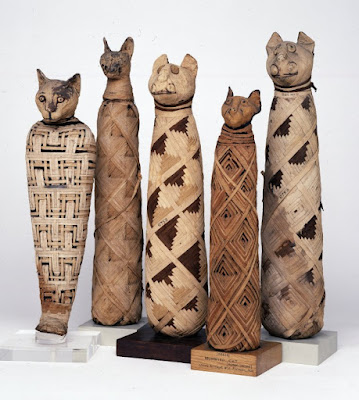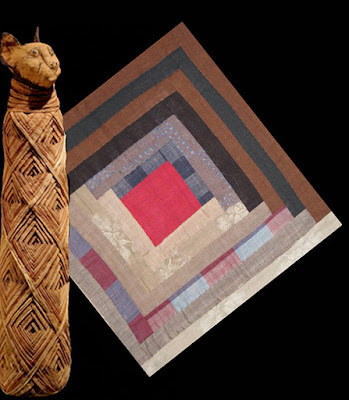Ancient Egyptian culture had a thing for cats
(For all I know current Egyptian culture may have a thing for cats.)
British Museum collection of cat mummies.
They have a good collection and the best online photos .
Ancient Egyptians mummified their cats, particularly in the First Millennium BC
---not THAT ancient.
Cat mummy/Field Museum
We're looking at the linen mummy wrappings here.
Linen-wrapped cat mummies were often placed inside sarcophagi.
New York Times
This all had something to do with religious worship of a cat god Bastet.
Of course I was immediately struck by the patterns in the mummy wrappings.
Perfect Sunshine & Shadow Log Cabin blocks
Courthouse Steps
And Housetops.
Now this is just a parallel design idea --- We can't conclude one affected the other.
Or is it?
But how could Egyptian cat mummy wrapping style from 1000 BC influence
patchwork quilt design in 1860s AD American and British quiltmaking?
Channeling Nefertiti
Options
1) Claiming an Egyptian past life. (Can't buy it.)
2) Some kind of inherited ancient cultural memory ala 19th-c-African design influencing 1940s African-American quilts.
(Can't buy it.)
2) Some kind of inherited ancient cultural memory ala 19th-c-African design influencing 1940s African-American quilts.
(Can't buy it.)
3) Spiritualists summoning Nefertiti and friends to 1860s seances.
(Can't buy it.)
4) 1860s women saw cat mummy wrapping designs.
(More likely than one would guess.)
Nineteenth-century entertainment venues included museums with a variety of exhibits. In New York there was Scudder's Museum where the exhibits included a stuffed bison, an 18-foot snake and a lamb with two-heads.
4) 1860s women saw cat mummy wrapping designs.
(More likely than one would guess.)
Scudder's American Museum 1810-1841
In Philadelphia the Peale's Museum showed family paintings, an Egyptian human mummy head as well as natural curiosities, the most famous being a skeleton of a mastodon.
Barnum's American Museum
P.T. Barnum bought Scudder's Museum in 1841 and added his own touch, including human exhibits like Tom Thumb, Cheng & Eng and several fraudulent assemblages purported to be previously unknown creatures.
The Feejee Mermaid was quite a draw, a public relations triumph.
Mummies fascinated the public too.
Egyptian culture and artifacts were fashionable once Napoleon's armies began plundering the area in 1799, instigating a trade in mummies, human and otherwise.
Dog mummy, Brooklyn Museum
Ibis bird mummy, Brooklyn Museum
Fertilizer?
The other way an American or British quiltmaker may have encountered a cat mummy is indeed strange. Entrepreneurs pillaging Egypt saw in the massive quantities of animal mummies potential as agricultural fertilizer. They exported boatloads of mummies to farmers. Whether the mummies were pulverized to linen, bone and other animal matter before the freight arrived in England and America is not clear but posts from Liverpool's World Museum indicate that the artifacts arrived intact---at least in an 1890 delivery.
"On 10th February 1890 an estimated 180,000 mummified cats, weighing 19.5 tons, were sold at auction at the docks in Liverpool. Almost all were crushed and spread on fields like manure but a few were saved and remain in World Museum."
Images from the World Museum
Now my theory is probably no better than the idea that quiltmakers had some deep, unconscious cultural memory of Egyptian design. But.....
Read more about animal mummies:
https://twitter.com/world_museum/status/731075138335084544
https://philadelphiaencyclopedia.org/archive/mummies/
https://exarc.net/issue-2018-1/ea/re-rolling-mummy-experimental-spectacle-manchester-museum
Curse of the Cat Mummy

























Hmmm... If I didn't know better, I'd say it was April 1st. Now I have heard it all! "Fur"tilizer indeed.
ReplyDeleteFur-tilizer in Maine I bet.
ReplyDeleteNo disrespect to the kitties, but I laughed out loud while reading this post. Maybe I'll name my future log cabin quilt "Mummified logs".
ReplyDeleteI've long fantasized about an exhibit using design elements (log cabin, tumbling blocks, etc.) executed in various media -- patchwork, ceramics, basketry, woodcarving, rugs, etc. And the term "log cabin"--I'm reading Quilt Treasures of Great Britain. The contributors refer to them as log cabin quilts, but I assume that the design was not called that by the makers since they didn't have log cabins in the UK.
ReplyDeleteI heard about the fate of the cat mummies before, but my memory recalls they were imported intending to be sold as collectibles, not fertilizer. But the optimism of the public in buying was vastly over rated, so that's when they ended up as fertilizer. I'm surprised that they weren't sold for paint pigment or medicines, maybe by that time those things were no longer done?
ReplyDeleteI don't think I've seen the mummies with wrappings that made log cabins and such, just the plain wrapped with painted features.
I read that the Victorians would buy Human Mummies (of lesser rank) and throw parties to unwrap them to amuse their guests. There were often little trinkets to be found in the wrappings which made it like a treasure hunt. Maybe they did this with Cat mummies to?! Or maybe they just payed more attention to mummy type artifacts because of their fascination with the whole culture?
ReplyDeleteThose Victorians did have A Lot of crazy ideas!
No Dog Cabins?
ReplyDeleteFeeling melancholy about the trivialization and disrespect of the remains of people and their loved and revered animals. The wrappings are fascinating, though. In a few thousand years our coffined and vaulted graves may be hot curiosities, too.
ReplyDeleteInsulting to use their babies ... aka mummified kitties... as FURTILIZER!
ReplyDelete